| May 24, 2007

[NIST Tech Beat Search] [Credits] [NIST Tech Beat Archives] [Media Contacts] [Subscription Information]

NIST Atom Interferometry Displays New Quantum Tricks
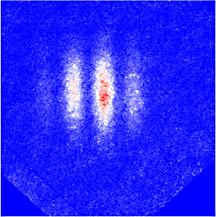 |
Atoms interfering with themselves. After ultracold atoms are maneuvered into superpositions—each one located in two places simultaneously—they are released to allow interference of each atom’s two “selves.” They are then illuminated with light, which casts a shadow, revealing a characteristic interference pattern, with red representing higher atom density. The variations in density are caused by the alternating constructive and destructive interference between the two “parts” of each atom, magnified by thousands of atoms acting in unison.
Credit: NIST
View hi-resolution image |
Physicists at the National Institute of Standards and Technology (NIST) have demonstrated a novel way of making atoms interfere with each other, recreating a famous experiment originally done with light while also making the atoms do things that light just won’t do. Their experiments showcase some of the extraordinary behavior taken for granted in the quantum world—atoms acting like waves and appearing in two places at once, for starters—and demonstrate a new technique that could be useful in quantum computing with neutral atoms and further studies of atomic hijinks.
The NIST experiments, described in Physical Review Letters,* recreate the historic “double-slit” experiment in which light is directed through two separate openings and the two resulting beams interfere with each other, creating a striped pattern. That experiment is a classic demonstration of light behaving like a wave, and the general technique, called interferometry, is used as a measurement tool in many fields. The NIST team used atoms, which, like light, can behave like particles or waves, and made the wave patterns interfere, or, in one curious situation, not.
Atom interferometers have been made before, but the NIST technique introduces some new twists. The researchers trap about 20,000 ultracold rubidium atoms with optical lattices, a lacework of light formed by three pairs of infrared laser beams that sets up an array of energy “wells,” shaped like an egg carton, that trap the atoms. The lasers are arranged to create two horizontal lattices overlapping like two mesh screens, one twice as fine as the other in one dimension. If one atom is placed in each site of the wider lattice, and those lasers are turned off while the finer lattice is activated, then each site is split into two wells, about 400 nanometers apart. Under the rules of the quantum world, the atom doesn’t choose between the two sites but rather assumes a “superposition,” located in both places simultaneously. Images reveal a characteristic pattern as the two parts of the single superpositioned atom interfere with each other. (The effect is strong enough to image because this is happening to thousands of atoms simultaneously—see image.)
Everything changes when two atoms are placed in each site of the wider lattice, and those sites are split in two. The original atom pair is now in a superposition of three possible arrangements: both atoms on one site, both on the other, and one on each. In the two cases when both atoms are on a single site, they interact with each other, altering the interference pattern—an effect that does not occur with light. The imbalance among the three arrangements creates a strobe-like effect. Depending on how long the atoms are held in the lattice before being released to interfere, the interference pattern flickers on (with stripes) and off (no stripes). A similar “collapse and revival” of an interference pattern was seen in similar experiments done earlier in Germany, but that work did not confine a pair of atoms to a single pair of sites. The NIST experiments allowed researchers to measure the degree to which they had exactly one or exactly two atoms in a single site, and to controllably make exactly two atoms interact. These are important capabilities for making a quantum computer that stores information in individual neutral atoms.
More information on quantum computing with neutral atoms can be found at www.nist.gov/public_affairs/quantum/quantum_info_index.html.
The authors are affiliated with the Joint Quantum Institute, created last year by NIST and the University of Maryland. The research was supported by the Disruptive Technology Office, Office of Naval Research, and National Aeronautics and Space Administration.
* J. Sebby-Strabley, B.L. Brown, M. Anderlini, P.J. Lee, W.D. Phillips, J.V. Porto and P.R. Johnson. 2007. Preparing and probing atomic number states with an atom interferometer. Physical Review Letters 98, 200405 (2007).
Media Contact: Laura Ost, laura.ost@nist.gov, (303) 497-4880 

NIST Antenna Calibrations Extended to 60-110 GHz
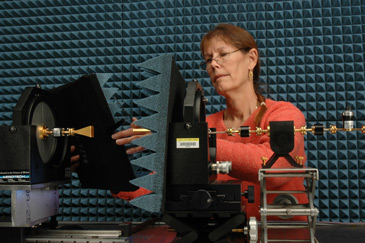 |
NIST engineer Katherine MacReynolds prepares a new NIST "tabletop" range for characterizing high-performance antennas, such as horn antennas (small gold pyramids) operating at 94 Gigahertz. The surrounding blue foam cones absorb electromagnetic fields to reduce scattering from nearby objects, thereby improving measurement accuracy.
Credit: © 2006 Geoffrey Wheeler.
To receive a high-resolution version of this image, contact Michael Baum. |
The National Institute of Standards and Technology (NIST) has developed a new “tabletop” sized facility to improve characterization of antennas operating in the 60 to 110 gigahertz (GHz) frequency range. This extended frequency capability serves needs for advanced civilian and military communication and radar systems.
Many electronic systems are moving to higher frequencies to attain higher channel capacity, better spatial resolution and other advantages. The new measurement facility will help accelerate development of technologies such as automobile collision-prevention radars, which operate at 94 GHz and require antennas small enough to be integrated into car bumpers. Improved NIST antenna calibration capability also helps to assure the accuracy of many systems. “NIST is the start of the measurement traceability chain,” says Perry Wilson, leader of the Radio Frequency Fields Group. “For instance, we calibrate the probes used by aerospace companies to calibrate instruments launched on satellites and other critical systems. Weather satellites are an example; improvements in antenna accuracy mean better data for weather models, resulting in better weather predictions.”
The new facility continues NIST’s history of innovation in antenna measurements, building on the “extrapolated gain” technique developed several decades ago. The original extrapolation range and techniques made it practical for researchers to accurately compute an antenna’s far-field characteristics based on near-field measurements. By making the range compact, costs are significantly reduced. In addition, the extrapolation technique uses over-sampling and averaging techniques to minimize the effects of scattering and range imperfections.
The tabletop extrapolation range is used to measure the gain (increase in signal power) and polarization (orientation of the electric field) of high-performance antennas. To make measurements, one antenna is fixed on the table and a second is moved along a rail. A laser tracker is used for alignment and positioning. The laser tracker is capable of following a moving target with less than 20 micrometer uncertainty at 1,000 points per second. The range is arranged on an optical table to provide the mechanical isolation and stability necessary to achieve low uncertainties at short wavelengths of radiation. Typical measurement uncertainty for certain types of antennas in the 60 – 110 GHz range approaches that of NIST’s existing calibration facilities for antennas operating at lower frequencies (less that 60 GHz).
For more details on NIST antenna calibration services, located at the institute’s Boulder, Colo., campus, see www.boulder.nist.gov/div818/81802/AntennaNearFieldMeas/index.html.
Media Contact: Laura Ost, laura.ost@nist.gov, (303) 497-4880 

New Fabrication Technique Yields Nanoscale UV LEDs
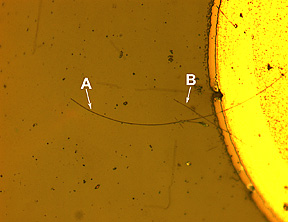 |
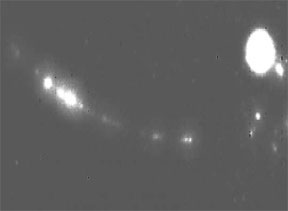 |
[Top] Micrograph of a complete nanowire LED with the end contact. The long nanowire (A) is about 110 micrometers long, a shorter nanowire (B) crosses it. The bright circular section is the metal post from which the nanowires are aligned.
View hi-resolution image
[Bottom] Optical image of the same nanowire in action. Most of the light emitted from the device is in the ultraviolet portion of the spectrum, but enough visible light is generated to see it glowing.
View hi-resolution image
Credit: NIST
|
Researchers at the National Institute of Standards and Technology (NIST), in collaboration with scientists from the University of Maryland and Howard University, have developed a technique to create tiny, highly efficient light-emitting diodes (LEDs) from nanowires. As described in a recent paper,* the fabricated LEDs emit ultraviolet light—a key wavelength range required for many light-based nanotechnologies, including data storage—and the assembly technique is well-suited for scaling to commercial production.
Light-based nanoscale devices, such as LEDs, could be important building blocks for a new generation of ultracompact, inexpensive technologies, including sensors and optical communications devices. Ultraviolet LEDs are particularly important for data-storage and biological sensing devices, such as detectors for airborne pathogens. Nanowires made of a particular class of semiconductors that includes aluminum nitride, gallium nitride and indium nitride are the most promising candidates for nanoscale LEDs. But, says NIST researcher Abhishek Motayed, “The current nanowire LEDs are created using tedious nanowire manipulation methods and one-by-one fabrication techniques, which makes them unsuitable for commercial realization.”
The NIST team used batch fabrication techniques, such as photolithography (printing a pattern into a material using light, similar to photography), wet etching and metal deposition. They aligned the nanowires using an electric field, eliminating the delicate and time-consuming task of placing each nanowire separately.
A key feature of the new nanowire LEDs is that they are made from a single compound, gallium nitride (GaN). Each LED consists of an “n-type” GaN nanowire placed on the surface of a “p-type” GaN thin film. “N-type” and “p-type” refer to semiconductors with, respectively, an abundance of electrons and an abundance of positively charged electron vacancies called holes. P-n junctions made from the same basic compound yield more efficient LEDs than those made with different compounds, and so can operate at lower power.
When the proper voltage is applied to the junction, it emits light with a peak wavelength of 365 nanometers, which falls squarely in the ultraviolet range. The group produced and tested more than 40 of these LEDs; all showed very similar emission properties. They also displayed excellent thermal stability—withstanding temperatures up to 750 degrees Celsius—and operational stability, showing no signs of deterioration even after two continuous hours of operation at room temperature. These properties indicate that this LED production method yields reliable, stable devices. The researchers say their method could be used to fabricate other nanowire structures as well as applications requiring a large area of nanoscale light sources.
*A. Motayed, A. Davydov, M. He, S. N. Mohammed and J. Melngailis. 365 nm operation of n-nanowire/p-gallium nitride homojunction light emitting diodes. Applied Physics Letters 90, 183120 (2007)
Media Contact: Michael E. Newman, michael.newman@nist.gov, (301) 975-3025 

Fiftieth Anniversary of First Digital Image Marked
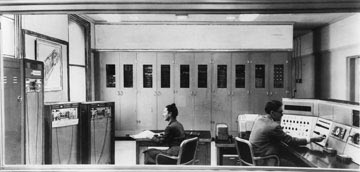 |
|
|
[Top] The room-sized Standards Eastern Automatic Computer (SEAC) was used to create the first scanned image.
View hi-resolution image
[Bottom L.] National Bureau of Standards (NBS) researcher R.B. Thomas shown operating the SEAC scanner (the control console is in the background).
View hi-resolution image
[Bottom R.] The first digital image made on a computer in 1957 showed researcher Russell Kirsch's baby son.
View hi-resolution image
Credit: NIST
|
|
It was a grainy image of a baby—just 5 centimeters by 5 centimeters—but it turned out to be the well from which satellite imaging, CAT scans, bar codes on packaging, desktop publishing, digital photography and a host of other imaging technologies sprang.
It was 50 years ago this spring that National Bureau of Standards (NBS, now known as the National Institute of Standards and Technology, or NIST) computer pioneer Russell Kirsch asked “What would happen if computers could look at pictures?” and helped start a revolution in information technology. Kirsch and his colleagues at NBS, who had developed the nation’s first programmable computer, the Standards Eastern Automatic Computer (SEAC), created a rotating drum scanner and programming that allowed images to be fed into it. The first image scanned was a head-and-shoulders shot of Kirsch’s three-month-old son Walden.
The ghostlike black-and-white photo only measured 176 pixels on a side—a far cry from today’s megapixel digital snapshots—but it would become the Adam and Eve for all computer imaging to follow. In 2003, the editors of Life magazine honored Kirsch’s image by naming it one of “the 100 photographs that changed the world.”
Kirsch and his wife Joan, an art historian, now reside in Oregon. Together, they use computers to analyze paintings and define the artistic processes by which they were created. Son Walden—whose face helped launch the era of computerized photography—works in communications for Intel following a successful career as a television news reporter.
Media Contact: Michael E. Newman, michael.newman@nist.gov, (301) 975-3025


New NIST Reference Material for Peptide Analysis
The National Institute of Standards and Technology (NIST) has issued its first-ever reference material designed to improve the performance and reliability of experiments to measure the masses and concentrations of peptides in biomolecular samples. The new reference material is expected to be an important tool in the analysis of proteins, both for disease diagnosis and drug discovery.
Proteomics—the study of proteins and the roles they play in biology—is one of the most fertile fields of modern medical research. Proteins typically are very large molecules, built of hundreds or thousands of amino acids, but they can be divided into smaller units, chains of about 50 or fewer amino acids. These are peptides. The usual way to analyze proteins is to chop them into their constituent peptides (generally with enzymes that cut through them at specific sites), sort the various peptides out using a chemical separation technique like high performance liquid chromatography (HPLC), and then determine the mass of each peptide using mass spectroscopy.
One big uncertainty in this process is that the peptide fragments differ in size, electrical charge and physical properties (such as the speed in which they separate under HPLC.) Chemists are accustomed to using well-known reference samples as chemical rulers to calibrate their analysis instrumentation, but until now there have been no such reference samples of peptides.
The need for this peptide reference material has been long recognized by the Association of Biomolecular Resource Facilities (ABRF), a non-profit standards organization created by representatives from industry firms, universities and government agencies. In collaboration with NIST, the ABRF created a Peptide Standards Project Committee to design and characterize three synthetic peptides to serve as the basis for a NIST peptide reference material. NIST RM 8327, “Peptide Reference Material for Molecular Mass and Purity Measurements,” consists of three peptides from 11, 14 and 26 amino acid residues in length, with net charges of -3, -1 and +3. These three synthetic peptides were designed to provide long-term stability (do not contain methionine, cysteine and tryptophan), a range of purities, a range of molecular masses, protease cleavage sites, and contain tyrosine to enable concentration analysis by UV spectroscopy.
Researchers from the University of Michigan; the University of Maryland; the University of Missouri; Texas A&M University; the University of Texas Health Science Center at San Antonio; Wake Forest University School of Medicine; Eli Lilly and Company; Xcellerex, LLC; BioReliance Inc., and Massachusetts General Hospital collaborated with NIST on the development of RM 8327. Details on the composition of the new peptide reference material and on how to purchase samples are available at https://srmors.nist.gov/view_detail.cfm?srm=8327.
Media Contact: Michael Baum, michael.baum@nist.gov, (301) 975-2763 

Guide Finds Criminals Hiding in Internet Data
Today, successful prosecution of crimes such as child pornography, identity theft, corporate embezzlement and credit card, retail and other types of online fraud often depend on an investigator’s ability to gather electronic evidence from the Internet and computer networks. To assist in these crime-fighting efforts, researchers at the National Institute of Standards and Technology (NIST) recently completed a new guide, Investigations Involving the Internet and Computer Network. The report, sponsored by the National Institute of Justice (NIJ), describes both how electronic networks work and how law officers can legally seek evidence of criminal activity on Web sites, electronic mail, chat rooms and file sharing networks.
The new guide offers relevant crime-fighting facts about Internet operation. It explains, for example, how a computer’s Internet Protocol (IP) address can be traced to a particular machine to discover the whereabouts of confidence artists who use email to cheat victims of their life’s savings, or people who connect to Web sites used for criminal purposes, such as distribution of child pornography. The guide describes how investigators can trace an IP address even if the target of the investigation attempts to hide it (“masking”), pretends to be someone else (“spoofing’), or sends the traffic through another IP address (redirecting).
Readers of the guide also receive useful information on catching criminals culpable of network intrusion (to steal user account names and passwords, to gain access to proprietary or confidential data, or to steal or destroy data) and "Denial of Service” attacks (designed to disrupt the target system’s ability to provide services and to prevent authorized users from accessing resources). In addition, the guide refers readers to helpful Web sites that carry updated information on viruses, Trojans and worms.
Although the report focuses on the technical aspects of the computer-related investigations, it notes that traditional investigative processes must also be followed. Witnesses must be identified and interviewed, evidence must be collected, the investigative process should be documented, and chain-of-custody and the legal process must be followed.
Federal law affecting state and local investigators—the Fourth Amendment, the Wiretap Act, the Pen Register and Trap and Trace Statute, the Electronic Communications Privacy Act, and the Privacy Protection Act—also are described. A discussion of legal issues, such as the need for preservation letters or orders, subpoenas and search warrants, concludes the report and samples of each are presented in the appendixes.
Investigations Involving the Internet and Computer Network may be obtained from the NIJ at www.ojp.usdoj.gov/nij/pubs-sum/210798.htm.
Media Contact: John Blair, john.blair@nist.gov, (301) 975-4261 

Small Business Asked for R&D SBIR Contracts Ideas
If you are the type of person who reads a Tech Beat story about a technology innovation and thinks “that research ought to be commercialized,” the National Institute of Standards and Technology (NIST) wants to hear from you. NIST’s Small Business Innovation Research (SBIR) Program is asking small business owners to examine NIST patents as well as other NIST-developed technology for commercial viability and to identify technological gaps that impede the patent’s transition to the marketplace. NIST intends to incorporate technologies of special interest to industry in its 2008 SBIR research and development solicitation for proposals.
NIST’s pilot effort to secure small business participation in formulating the SBIR solicitation is aimed at increasing private-sector commercialization of innovations derived from federal research and development.
The NIST SBIR Program is inviting small, American-owned companies to scan NIST patents and technologies and offer research suggestions in advance of the 2008 SBIR solicitation. In that competition, NIST will offer awardees a non-exclusive research license and the option to a non-exclusive commercialization license. The company or companies selected for the SBIR award, with access to NIST technology and personnel knowledgeable about the NIST patent, will be expected to add research to the NIST innovation and develop a commercial product based on the NIST patent. The deadline for private sector suggestions to the solicitation is Aug. 31, 2007; the formal solicitation is expected to be issued in November 2007, with proposals due in late January 2008.
The NIST SBIR program typically includes “Proof of Concept” contracts of as much as $75,000 over six months) that if successful can evolve into “Research and Development Prototype Development” contracts (as much as $300,000 over two years). The NIST program is part of the national SBIR program. Federal law mandates federal agencies with research and development budgets of $100 million or more to reserve 2.5 percent of that budget for SBIR funding agreements with small technology-oriented firms.
Information on NIST patents and technology can be found searching Tech Beat archives at www.nist.gov/public_affairs/techbeat/archive.htm and at www.nist.gov/patents. To search all NIST patents in the latter Web site, check the box “Restrict to Licensable Technologies” in #1 and leave all search methods blank, and then simply click “search” button to view all pending and issued patents).
Small companies that identify NIST-held patents, or other NIST technologies that are not patent protected, and wish to explore opportunities to conduct research to further the technology to transition to the commercial market should call Clara Asmail, NIST SBIR Program Manager, (301) 975-2339 or email her at: asmail@nist.gov.
Media Contact: John Blair, john.blair@nist.gov, (301) 975-4261 

Quick Links
New Book Explores Intelligent Vehicle Systems
A new book edited by three National Institute of Standards and Technology (NIST) researchers examines advances in autonomous vehicle technology, and anticipates likely progress toward “intelligent autopilots” for automobiles and trucks in the coming two decades. The book presents an in-depth look at theoretical foundations and engineering approaches that enable intelligent vehicle capabilities.
Intelligent Vehicle Systems: A 4D/RCS Approach begins with a brief introduction to the basic control system model discussed in the book. The 4-Dimensional/Real-Time Control System (4D/RCS) is a reference model architecture for an automated control system, and a design methodology that has proven successful in guiding the development of autonomous mobility systems. Detailed information on the NIST-developed RCS can be found at www.isd.mel.nist.gov/projects/rcs/ and in 4D/RCS: A Reference Model Architecture for Unmanned Vehicle Systems Version 2.0 at www.isd.mel.nist.gov/documents/albus/4DRCS_ver2.pdf.
Five subsequent chapters examine the role that theories of perception, world modeling, knowledge representation, task decomposition, and planning and control play in the design of intelligent vehicles. An additional chapter focuses on laser detection and ranging (LADAR) technology, a key enabler for both driving and collision-avoidance, and two chapters examine the standards landscape and performance measures for intelligent autonomous vehicles. The book closes with a history of research in autonomous mobility by the U.S. Army and the Defense Advanced Research Projects Agency (DARPA), and a perspective on future directions for intelligent vehicle systems.
Copies of Intelligent Vehicle Systems: A 4D/RCS Approach, edited by Raj Madhavan, Elena Messina and James Albus, of NIST Intelligent Systems Division, are available from Nova Science Publishers at https://www.novapublishers.com/catalog/product_info.php?products_id=4545 or from Amazon.com.
Foundation Marks 30 Years of U.S./Israeli Innovation
If two heads are better than one, then two companies should be a lot better. An unusual program that matches up U.S. and Israeli companies for joint development of innovative products certainly helps prove this point.
The Israel-U.S. Binational Industrial Research and Development (BIRD) Foundation was created in 1977 to help U.S. and Israeli companies fund R&D partnerships offering mutual benefits. Since then the program has leveraged a $110 million endowment into cost-shared funding for 743 projects that in turn produced roughly $8 billion in direct and indirect revenues, according to BIRD executive director Eitan Yudilevich.
Examples of new products jump-started by BIRD range from a better camera for endoscopes to batteries for an electrically powered bus to a new drug for treating seasonal allergies. Companies repay their joint BIRD grants through royalties on sales only if the collaboration results in a successful commercial product.
On June 19, 2007, the U.S. National Institute of Standards and Technology (NIST), the U.S. National Academy of Sciences (NAS), Israel’s Office of the Chief Scientist, and the Embassy of Israel will help the foundation throw a 30th birthday party for itself in the form of a half-day seminar that celebrates BIRD success stories. The meeting will be held at the NAS in Washington, D.C.
Keynote speakers include Mark M. Little, senior vice president and director of General Electric Global Research, and Vinton G. Cerf, vice president and chief Internet evangelist for Google. Other featured speakers include John D. Negroponte, deputy secretary of state, U.S. Department of State; Sallai Meridor, Iraeli ambassador to the U.S., Embassy of Israel; and Robert Cresanti, under secretary of commerce for technology, U.S. Department of Commerce.
For a full program and registration information, see www.birdf.com.
Honors for NIST Researchers Announced
Physicists Scott Diddams and Svenja Knappe of the National Institute of Standards and Technology (NIST) Time and Frequency Division have been named as winners of the European Young Scientist of the Year Award from the European Frequency and Time Forum (EFTF), to be presented at the joint meeting of the IEEE Frequency Control Symposium (FCS) and European Frequency and Time Forum in Geneva the last week of May 2007. The award is presented to outstanding scientists under the age of 40 who have significantly advanced the science of time and frequency measurement. Diddams is being recognized for his work on femtosecond laser frequency combs, Knappe, a NIST guest researcher, for her work on chip-scale atomic devices.
Physicist Leo Hollberg of the NIST Time and Frequency Division has been named a winner of the I. I. Rabi Award from the IEEE Frequency Control Symposium, also to be presented at the May meeting. The award recognizes outstanding contributions related to the fields of atomic and molecular frequency standards, and time transfer and dissemination. Hollberg is being recognized for leadership in ultrastable lasers, optical atomic clocks, optical frequency combs, chip-scale atomic devices, and other applications of optical measurements.
Physicist Deborah Jin of the NIST Quantum Physics Division and JILA, a joint venture of NIST and the University of Colorado at Boulder, has been elected to the American Academy of Arts and Sciences. The AAAS was founded in 1780 by John Adams, James Bowdoin, John Hancock and other scholar-patriots, and annually elects new members as Fellows and Foreign Honorary Members from the scholars, scientists, artists, civic, corporate and philanthropic leaders of the world. The current membership includes more than 170 Nobel laureates and 50 Pulitzer Prize winners. For more details, see www.amacad.org/news/new2007.aspx
Jin also was honored with a lifetime achievement award in science by the Bonfils-Stanton Foundation for her work in the field of ultracold Fermionic (atomic) gases. The Bonfils-Stanton Foundation is a private, non-profit corporation created to enhance the quality of life for residents of Colorado.

|

